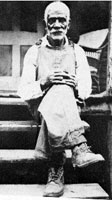BLACK COAL MINERS
A long legacy of struggle
By
Stephen Millies
Published Jan 29, 2006 7:46 PM
African Americans have been mining coal and
fighting bosses for over 200 years. Slaves were working in coal mines around
Richmond, Va. as early as 1760. During the Civil War, a thousand slaves dug coal
for 22 companies in the “Richmond Basin.”
|
A 90 year-old ex-slave
miner, West Virginia, 1921.
|
Black miners were
expected to load four or five tons of coal. Slaves able to fill this quota were
fed supper. Those who couldn’t were whipped.
Slavery in the mines
didn’t end after the war in 1865. For decades prisoners convicted of
“vagrancy” and “loitering” worked as virtual slaves for
private outfits in Alabama, Georgia and Tennessee. From 1880 to 1904, 10 percent
of Alabama’s state budget was paid by leasing prisoners to coal
companies.
African Americans accounted from 83 percent to 90 percent of
these slave miners in Alabama. Sixty-nine percent of Tennessee prisoners digging
coal in 1891 were Black. Some poor whites were railroaded to jail
too.
Conditions were horrendous in these convict mines. Nearly one out of
ten prisoners died annually at the Tracy City, Tenn. mine operated by the
Tennessee Coal and Iron Company (TCI).
|
Miner lighting a fuse, 1923.
|
TCI was bought by United States
Steel in 1907. USS continued to operate TCI’s mines in Alabama for another
20 years. Reparations are owed by USS and the JPMorgan/Chase Bank whose
financial ancestor set-up this steel Goliath as the first billion-dollar
corporation in 1900.
Three hundred miners with guns freed prisoners at
TCI’s Briceville, Tenn. facility on July 15, 1891. The following week
1,500 miners returned to free more prisoners. H.H. Schwartz of the Chattanooga
Fed eration of Trades reported that “whites and Negroes are standing
shoulder to shoulder” and armed with 840 rifles.
James Knox, an
African American convicted of passing a $30 bad check, was tortured to death by
guards at Alabama’s Flat Top mine on Aug. 14, 1924 because he was unable
to meet the mine’s daily ten-ton quota.
The uproar over this murder
finally forced Alabama to shut down its slave mines. On July 1, 1928, 499 Black
prisoners singing the “Negro” spiritual, “Swing Low, Sweet
Chariot”, turned in their lamps and picks for the last
time.
Black labor summoned
to the mines
By 1930
there were over 55,000 Black coal miners. That year African Americans accounted
for 53 percent of Alabama’s coal diggers.
These Alabama miners went
on strike in 1894, 1904 and 1908. Eleven thousand miners—75 percent of
whom were Black—struck again from Sept. 7, 1920 to March 12, 1921. Among
the Black leaders were J. F. Sorsby, United Mine Workers Dis trict 20
vice-president, and International organizers, William Prentice and George H.
Edmunds.
Despite bold tactics that included dynamiting a Southern Railroad
train carrying scab coal, the strike was crushed by the National Guard. At least
16 people were killed. But the UMW came back to organize these mines in the
1930s during the Great Depres sion when militant struggles were being carried
out by labor.
Twenty-two thousand African Ameri cans were employed in West
Virginia’s mines in 1930. Black and white miners there fought side-by-side
in the Paint Creek-Cabin Creek strike of 1913-14. The Black union man known as
“Few Clothes” Dan Chain —portrayed by James Earl Jones in the
powerful John Sayles film, “Matewan”—became legen dary for his
courage.
The “mine wars” in Mingo and Logan counties from 1919
to 1921 produced the big gest armed confrontation in U.S. labor history. Logan
County Sheriff Don Chaffin was paid $32,700 a year (worth about $400,000 today)
by mine owners to keep out union organizers.
Following the assassination
of the pro-union sheriff Sid Hatfield on Aug. 1, 1921, 8,000 armed miners, one
quarter of whom were Black, marched on Logan County. While ten union members
were killed at Blair Mountain, one hundred of Chafflin’s mercenaries were
slain.
Army Gen. Billy Mitchell wanted to bomb the miners. Only the
dispatch of 2,500 soldiers by President Warren G. Harding prevented the
union’s victory.
The mechanization of mines has wiped out 400,000
union jobs since 1950. Black workers were targeted first for dismissal. Just a
few thousand African Americans are working in mines today.
The 14 miners
killed last month in West Virginia were white. Most of the people who drowned in
New Orleans in the aftermath of Hurricane Katrina were Black. Capitalist greed
and the Bush administration are responsible for all of their
deaths.
Sources: Black Coal Miners in Ameri ca by Ronald L. Lewis
(The University Press of Kentucky, 1987) and Coal, Class and Color, Blacks in
Southern West Vir ginia, 1915-1932 by Joe William Trotter, Jr. (University of
Illinois Press, 1990).
Articles copyright 1995-2012 Workers World.
Verbatim copying and distribution of this entire article is permitted in any medium without royalty provided this notice is preserved.
Workers World, 55 W. 17 St., NY, NY 10011
Email:
[email protected]
Subscribe
[email protected]
Support independent news
DONATE


